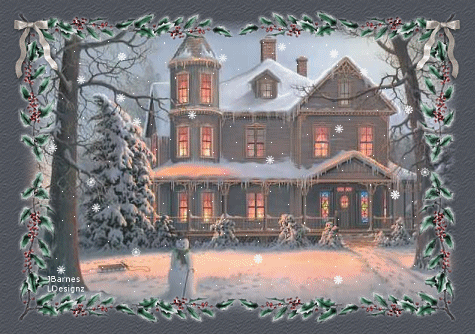

Twinkling lights hung on fragrant boughs,
laced with golden antiquities; garlands strung
from the mantle, framing a glowing fire of
crackling pinecones; the family Bible
prominently displayed on a table, opened to the
greatest story ever told. Walking from room to
room, the heavenly scents of fir, pine, hemlock,
sweet spices of cinnamon, cranberry, and apple
fill the air. Windows are frosted and the walls
faintly shudder with the howl of the snow-laden
winds outside. Guests filter in and leave their
calling cards at the foyer desk, each one a
brightly decorated token of the season. Names
are crisply spelled out in fine script,
surrounded by pictures and designs in bright,
cheery colors. The mail basket is overflowing
with cards lavishly printed with the lithographs
of Currier & Ives and Louis Prang. A
scrapbook in the parlor, another in the
children’s playroom, announce with
appropriately selected pages, that Christmas is
here in all its spectrum and splendor.
When we celebrate Christmas with family and
friends, we have the Victorians to thank for
many of its joyful festivities and delightful
customs. They revived old traditions, such as
caroling, and invented new ones such as sending
Christmas cards.
The Victorians also promoted church-going,
gift-giving, and charity to the poor as
essential parts of the holiday. They transformed
the folk figures of Father Christmas and Santa
Claus into symbols of holiday generosity, and
they greatly popularized Germany's traditional
Christmas tree or Christbaum
Most of all, the Victorians made Christmas a
family celebration, with its primary focus on
the Christ Child and children. A Victorian
Christmas entailed the exchange of gifts between
parents and children; attendance together at
Church services; a multi-course family dinner;
and visits with friends, relatives, and other
families.
Behind the double doors of the
Victorian parlor stood the Christmas tree, an
old German custom the Victorians enlarged upon
both in style and decoration. This tradition had
come to England by way of Queen Victoria's
great-great-grandfather King George I.
When she was Queen, Victoria had a Christmas
tree at Windsor Castle. In 1848, an etching of
Victoria, Albert, and their children gathered around
their decorated tree was published in The
Illustrated London News. At about the same time,
Charles Minnegerode, a German professor at the
College of William and Mary, trimmed a small
evergreen to delight the children at the St.
George Tucker House. Martha Vandergrift, aged
95, recalled the grand occasion, and her story
appeared in the Richmond News Leader on December
25, 1928. Presumably Mrs. Vandergrift remembered
the tree and who decorated it more clearly than
she did the date. The newspaper gave 1845 as the
time, three years after Minnegerode's arrival in
Williamsburg. Perhaps the first Christmas tree
cheered the Tucker household as early as 1842.
As a result, Christmas trees became the popular
fashion in England and the central feature of
the Victorian family Christmas. German settlers
had brought the custom to America, but when the
same illustration of Victoria and her family
appeared in Gody's Lady's Book in 1850,
Christmas trees became even more popular in
American then in England.
What made the Victorian Christmas tree so
special was its elaborate decoration.
Decorations included gingerbread men, marzipan
candies, hard candies, cookies, fruit,
cotton-batting Santas, paper fans, tin soldiers,
whistles, wind-up toys, pine cones, dried
fruits, nuts, berries, and trinkets of all
kinds. Paper cornucopias filled with nuts,
candies, and other treats were the Victorian
favorite. It was not uncommon to find some small
homemade gifts, such as tiny hand-stitched dolls
or children's mittens, and freshly baked treats
like sugar cookies. Hand-dipped candles were
placed carefully on each of the branches. A
Christmas doll or angel could usually be found
adorning the top of the tree.
Children often helped to make the tree
decorations. They would string garlands of
popcorn or cranberries, or make chains of paper
flowers. Some families set up a Nativity or
outdoor scene under the tree, using moss for
grass and mirrors for ponds.
Later in the century imported ornaments from
Germany began to replace the homemade ones.
First came glass icicles and hand-blown glass
globes called kugels. Dresdens, which were
embossed silver and gold cardboard ornaments,
took exotic shapes--moons, butterflies, fish,
birds, ships, animals, flowers, trolley cars,
and even automobiles.
A Victorian family's most prized ornament was
the Nuremberg angel atop the tree. It had wings
of spun glass, a crinkled gold skirt, and a wax
or bisque face. Angles or cherubs represented
the Victorian ideal of childlike or womanly
innocence.
From A
Victorian Christmas

